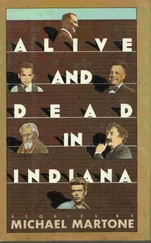THE BLIND
He said, first there is the engine. He said, first there is the engine and then the tender. He said, the tender's where they keep the coal and the water for the engine. He said, the blind's between the tender and the baggage car that comes next. He said, the blind's the doorway on the baggage car. He said, the baggage car door is locked but you can ride in the doorway. He said, riding in the doorway of the baggage car is riding the blind. He said, he liked to ride the blind. He said, a passenger train goes three times as fast. He said, in the summer there is nothing better. He said, in the winter you have to think twice. He said, in the winter you have to think twice because those trains take water on the fly. He said, those flyers take on water on the fly. He said, they don't stop for water. He said, they have to make up time. He said, they don't stop for water, they get it on the fly. He said, what that means is the water is in a trough between the rails. He said, the water is in a trough between the rails and the tender scoops it up without stopping. He said, the tender has a scoop that drops into the water. He said, the engine doesn't stop. He said, the engine doesn't stop when picking up water on the fly. He said, the water flies when they pick up water on the fly. He said, the blind gets soaked by all the water flying. He said, he's been soaked by all that water. He said, you don't want to see the blind in winter. He said, you don't want to see the blind in winter when the train is picking up water on the fly. He said, the whole head-end of the baggage car is covered with ice. He said, ice from the water spilled back from picking up water on the fly. He said, the water freezes when it hits the cold metal of the baggage car. He said, I've seen them hacking at the blue ice with axes. He said, I've seen them melt the blue ice with steam. He said, riding the blind in winter. He said, riding the blind in winter, in the night. He said, riding the blind in winter, in the night, when the flyer takes on water on the fly. He said, I've seen that.
NOT IRONIC
You know the scene. A great ocean liner is about to depart on a transatlantic cruise. The ship's orchestra plays “Columbia, the Gem of the Ocean.“ Passengers lining the many decks dockside wave and wave flags, throw, toward the mass of well-wishers stories below, brightly colored streamers that stream through the flurry of confetti falling through the cold air. Without warning, the ship's horn warns of the impending departure. The vessel trembles, then drifts free of its moorings, begins to slide forward and away from the dock. The band blares over the overdubbing of the plosive hubbub of the throng. Bon Voyage! You regard the illuminated ranks of the passengers as each animated face searches for one last glimpse of a loved one or ones on shore, your own gaze panning the panoply of people packed along the brilliant white railings. Then the crowd parts, and you peer deeper into the ship's graceful superstructure. Revealed there, suspended, it seems, floating even, on the white wall of the bulkhead, a wreath-like orange life buoy, the stenciled name of the ship orbiting the rim: SS Orizaba .
SLIGHTLY IRONIC
You know the scene. A great ocean liner is about to depart on a transatlantic cruise. The ship's orchestra plays “Anchors Aweigh.“ Passengers lining the many decks dockside wave and wave flags, throw, toward the mass of well-wishers stories below, brightly colored streamers that stream through the flurry of confetti falling through the cold air. Without warning, the ship's horn warns of the impending departure. The vessel trembles, then drifts free of its moorings, begins to slide forward and away from the dock. The band blares over the overdubbing of the plosive hubbub of the throng. “From the halls of Montezuma to the shores of Tripoli.“ Bon Voyage! You regard the illuminated ranks of the passengers as each animated face searches for one last glimpse of a loved one or ones on shore, your own gaze panning the panoply of people packed along the brilliant white railings. Then the crowd parts, and you peer deeper into the ship's complicated superstructure. Revealed there, suspended, it seems, floating even, on the white wall of the bulkhead, a wreath-like orange life buoy, the weathered stenciled name of the departing ship orbiting the rim: SS United States .
IRONIC
You know the scene. A great ocean liner is about to depart on a transatlantic cruise. The ship's orchestra plays “Rule, Britannia.“ Passengers lining the many decks dockside wave and wave flags, throw, toward the mass of well-wishers stories below, brightly colored streamers that stream through the flurry of confetti falling through the cold cold air. Without warning, the ship's steam whistle warns of the impending departure, the ship's big bell tolling. The vessel trembles, heaves forward, then drifts free of its moorings, sliding away from the teeming dock. The band blares over the overdubbing of the plosive hubbub of the throng. “God save the…“ Bon Voyage! Bon Voyage! You regard the thick ranks of the passengers as each bright face searches in a slight panic for one last glimpse of a loved one or ones on shore, your own distant gaze panning the panoply of people packed along the delicate white railings. Then the crowd parts, and you peer deeper into the ship's shadowed superstructure. Revealed there, suspended, it seems, floating even, on the ice-white wall of the bulkhead, a small wreath-like orange life buoy, the matte-black stenciled name of this departing ship orbiting the rim: RMS Titanic .
NOW STRANGELY IRONIC
You know the scene. A great ocean liner is about to depart on a transatlantic cruise. The ship's orchestra plays “Columbia, the Gem of the Ocean.“ Passengers lining the many decks dockside wave and wave flags, throw, toward the mass of well-wishers stories below, brightly colored streamers that stream through the flurry of confetti falling through the cold air. Without warning, the ship's horn warns of the impending departure. The vessel trembles, then drifts free of its moorings, begins to slide forward and away from the dock. The band blares over the overdubbing of the plosive hubbub of the throng. Bon Voyage! You regard the illuminated ranks of the passengers as each animated face searches for one last glimpse of a loved one or ones on shore, your own gaze panning the panoply of people packed along the brilliant white railings. Then the crowd parts, and you peer deeper into the ship's graceful superstructure. Revealed there, suspended, it seems, floating even, on the white wall of the bulkhead, a wreath-like orange life buoy, the stenciled name of the ship orbiting the rim: SS Orizaba .
You wait as this final ship shrinks in the vast distance, sinks over the horizon with a sanguine southern sun (setting or rising, you can't be sure) steaming over its starboard quarter, the ignited sky a kind of stained wake, and this illusion of perspective, the vectored strata of clouds, the lapping waves and the wrinkled ocean beyond, creating in you the sensation that you, you are the one in motion, bobbing, moving further away from the once massive static ship, now mere punctuation, shifting with its cheerful and optimistic manifest of passengers, now a smudge of smoke, a quotation of exhaustion, on the vast yet retreating horizon. You sense that you yourself are sinking, or so it seems. You are shipping water, floundering, adrift even, and cast about for any buoyant jetsam within your reach, its stenciled letters awash, washed out, unreadable, an “S“ maybe and another “S“ on the water-logged lifesaver, the only “O“ the one you mouth, “O“, in recognition. Oh, you tell yourself, you get it now, though you can no longer name that ship-shaped vessel that has been launched with such choreographed fanfare or (to tell the truth) tell among the various ways of telling: what is happening, what will happen, what you know will happen, and what (at last) you know you know will happen.
Читать дальше












